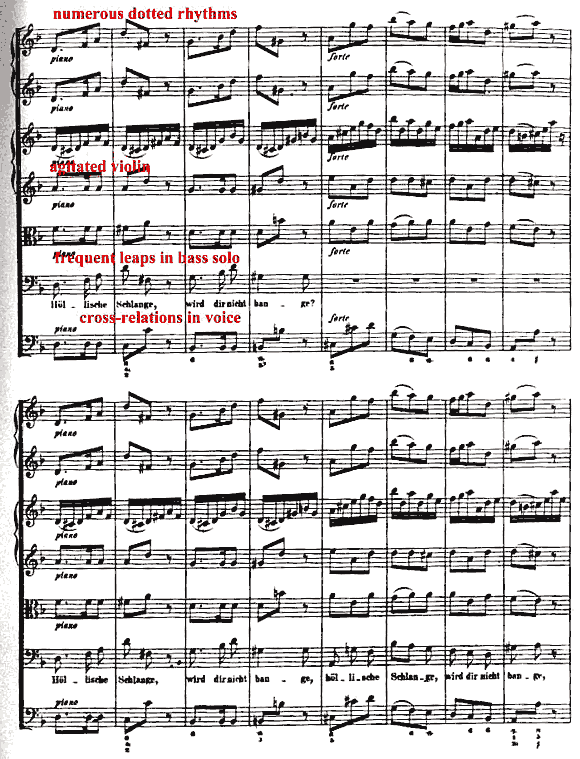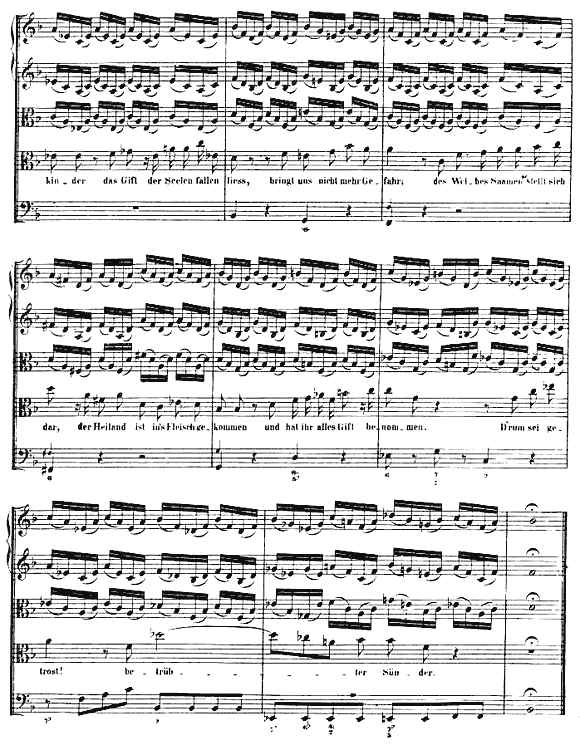This cantata has been described as “one of the most perfect, every number is of superb quality. It is, indeed, truly representative both of the composer’s religious outlook and of his supreme inventive and imaginative powers” (see Alec Robertson, The Church Cantatas of J.S. Bach, New York: Praeger Publishers, 1972). Written for the second day of Christmas, Cantata 40 was the first performed as part of Jahrgang I in Leipzig (1723). It follows one of Bach’s most common structural patterns, especially among his early Leipzig cantatas:
Biblical citation
Recitative
Chorale
Aria
Recitative
Aria
Chorale
Cantatas 40, 48, 64, 67, and 153 all follow this structure. Bach inserts an additional chorale (a four-part setting, as are the other two in this cantata) between the second recitative-aria pair as well, both giving this greater parallelism and contributing to the “communal feeling of this work” (according to Stephen A. Christ). This would have allowed for greater congregational participation.
Cantata 40 is written “for the second day of the Christmas Feast”. In Bach’s day, the celebration of Christmas lasted three days: December 25-27. This cantata was performed on the 26th. In modern times, we extend the celebration of Christmas unofficially in both directions before and after the 25th (mostly before, judging from the displays in many department stores), and the days are filled with levity, celebrating the joy at Christ’s birth. It may be surprising, therefore, to hear the more subdued joy of this work, which “encapsulates…the opposition between Jesus, who entered the world on Christmas Day, and the Devil, whose works are to be destroyed by the powerful Son of God” (Stephen A. Christ, in J.S. Bach, ed. Malcolm Boyd, Oxford Unviersity Press, 1999). Musically, the presence of horns instead of trumpets helps soften the sound. That all movements are set on the “flat side” also softens the overall sound of the cantata, especially compared to Cantata 147. There is still joy, but it is tempered with the knowledge that the Christ Child’s destiny is to grow up to confront Satan, and to sacrifice his own life that we might be saved. No where in the cantata is Bach’s personal belief in the Messiah more evident than in this opening chorus. In the entire 80 measures, Bach sets a single line of text:
Darzu ist erschienen der Sohn Gottes, daß er die Werke des Teufels zerstöre.
(For this is appeared the Son of God, that he may destroy the works of the Devil.)
The insistent focus on this idea, created by the constant repetition, in different ranges and textures, brings the purpose of the Incarnation to focus; the focus on this cantata therefore will be on humanity: Christ, in his human form, will confront Satan and all things evil; we, as humans, are both the root cause which leads to Christ’s Incarnation and the beneficiaries of the results of his death and resurrection.
In a very straightforward manner, the tenor recitative which follows immediately focuses our attention on the merging of God and humanity:
The word was flesh and dwelled in the world
The world’s true light does shine throughout the earth now
The mighty Son of God has left the throne of heaven…
The king has become a subject
The Lord appears as a servant for this mortal race of man…
The music is rather uneventful, but does redirect our attention from the joy of Christmas Day to the inevitable conclusion which awaits the Son of God as man. The chorale (movement 3) turns darker in tone, set in g minor, and with good reason: we come to realize that our sins have been the trigger for Christ’s descent to earth. The following bass aria develops further the theme of Satan’s destruction. Though this destruction should be a joyful event, the battle between God and Satan is depicted in a strong, fierce fashion:
- a quick tempo
- abundant dotted rhythms
- a d minor tonality
- frequent cross-relations in close proximity (F followed shortly by F-sharp)
- an agitated, active first violin part
- frequent leaps in the bass solo

This has all the elements of a “rage aria”, a common device in operas during Bach’s time. Though Bach himself never wrote an opera, he was familiar with the works of Alessandro Scarlatti, among the greatest and certainly most prolific opera composers of the Baroque. And this is appropriate here, for if Satan is not angry, he is at the very least defiant, a feeling which Bach gets across in admirable fashion.
The ‘perpetual motion’ of the first violins in the preceding bass aria extends into the next movement, an accompanied recitative for alto solo. The motion here has a completely different effect, however, with violin I, violin II, and viola all participating harmoniously in a slower tempo and more peaceful B-flat major. Here, the alto shifts our focus to allow us to “take comfort, then, O troubled sinner” now that the serpent has lost his sting, rather than to dwell on the sorrow of Christ’s sacrifice any longer. The recitative is not without its dissonant moments (such as the diminished 7th chord on “Gift” [poison]), but clearly the intent is to shift our focus back away from sorrow to gladness (or at least comfort).

The joy we feel through the knowledge that Christ’s sacrifice offers salvation to all believers is evident in the final aria for tenor (the penultimate movement of Cantata 40), but the relative darkness of the final chorale setting re-centers the focus on humanity. It is a plea for comfort, peace, gladness, and a blessed new year. Its sound harkens somewhat to the first Brandenburg Concerto, with the F major key, upbeat tempo, dance-like feel, and mix of strings, horns, and oboes. We also have in this movement the unusual image of Jesus as a mother hen protecting his chicks under his wings. We frequently hear of Christ caring for humanity as the good shepherd protects his flocks, but this hen image is more obscure. It does, nonetheless, have biblical origins: Christ himself says “How often would I have gathered your children together as a hen gathers her brood under her wings…” (Matthew 23:37).










































